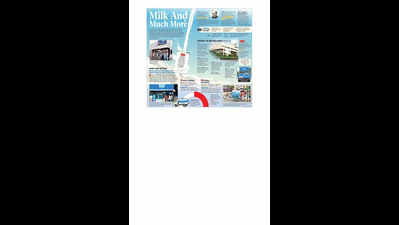

New Delhi: Exactly 50 years ago, Delhiites witnessed a small but revolutionary shift in their daily routines when four Mother Dairy booths opened in their neighbourhoods. These booths were not just another addition to the city’s landscape — they marked the debut of a concept that would soon capture the imagination of city residents.
At Mother Dairy booths in Defence Colony, Malviya Nagar and two in RK Puram, morning milk buyers marvelled as, for the first time, they inserted a coin in the slot and out flowed milk.It was 1974 and around the same time, Mother Dairy set up its first dairy plant in east Delhi’s Patparganj. This novel idea was the brainchild of National Dairy Development Board, led by Dr Verghese Kurien, known as the father of the White Revolution in India. It was created under the Operation Flood initiative, the world’s largest programme for dairy development, aimed at making India a milk-sufficient nation. The goal was to provide a reliable and hygienic source of milk to urban populations while also supporting dairy farmers by streamlining the supply chain.
“NDDB’s efforts fundamentally transformed India’s rural economy by making dairying viable and sustainable for millions of cow owners, while also addressing the country’s need for self-sufficiency in milk production,” said Dr Meenesh Shah, chairman, NDDB and Mother Dairy. “This transformation wouldn’t have been possible without institutions like Mother Dairy, which play a crucial role in the value chain connecting cows with consumers. With one million farmers in 30,000 villages and millions of consumers, the brand has a strong foundation of trust.”
Before Mother Dairy, the Delhi Milk Scheme served as the city’s primary source of milk. Launched on Nov 1, 1959, by then President Dr Rajendra Prasad, the scheme operated from a large facility in west Delhi’s Shadipur and established numerous booths across the city. Bottled milk from DMS was delivered to these booths twice daily in the morning and evening.
At the DMC booths, people often faced long lines collecting their supplies, with the buyers often resorting to marking their places with stones and other objects and returning later for their turn to buy milk. Others relied on local milkmen.
After 15 years of DMC, Delhi residents had an entirely new experience of buying milk. The initial reception to Mother Dairy was a mix of curiosity and scepticism. The concept of vending machines dispensing fresh milk was unfamiliar and, to many, a touch surreal. Yet, the quality and convenience of the products quickly won over the public. The booths, with the iconic white and blue logo, became a symbol of efficiency.
“Being no longer reliant on the milkman for daily supply was a novel experience,” recalled Usha Srivastava, 78. “Trust was a significant concern because we were never certain about the milk sold by the milkman since he often diluted it with water. In contrast, these booths felt incredibly reliable. Although we had to stand in queues to purchase milk, it was worth the wait. I remember buying milk for just Rs 5 per litre.”
The brand’s success in Delhi was not just about innovation, it was about solving a pressing problem. In the early ’70s, the city faced challenges in supplying consistent and clean milk. The booth system addressed these issues by excluding intermediaries and reducing the chance of contamination.
As Delhi evolved, so did Mother Dairy. The company started using new technologies and practices to stay relevant in a changing market. The introduction of packaged milk and modern distribution channels further solidified its position as a leader in the dairy sector.
“We evolved alongside our consumers, transitioning from offering token milk to an array of dairy products, including mishti doi, kulfis, milk cake, and yoghurts,” said Manish Bandlish, managing director, Mother Dairy. “From our humble beginnings with just four booths in Delhi, we have come a long way in 50 years. And as we celebrate our heritage, we want to expand, enhance our production capacities and diversify our product range.”
With the solid groundwork of the early years, Mother Dairy expanded rapidly, making it a familiar and reassuring sight in the city neighbourhoods. It now has around 2,500 outlets in Delhi-NCR that supply 35 lakh litres of milk every day. All Mother Dairy booths are run by ex-servicemen. “As we enter our next phase, we are committed to making our presence felt both within the country and in international markets, contributing to our nation’s vision of becoming the dairy to the world,” Shah added.
By the ’80s and ’90s, alongside widening its network of booths, it also ventured into the retail market with a range of dairy products, including butter, cheese and ice cream. Mother Dairy’s horticulture brand, Safal, came into being in 1986, offering fruits and vegetables, frozen vegetables, ready-to-eat snacks, pulses, grains, pickles, etc.
Another detour was the launching of Dhara in 1988, bringing packaged edible oil to the neighbourhood kiosk. Apart from these products, the brand also began selling curd, flavoured milk, lassi, ghee, chaach, fruit yoghurt, milk cake, milkshakes, dairy whitener, cream, and sweets like orange mawa barfi, rasmalai, kaju katli, shahi kulfi, custard, even cold coffee and haldi milk.
In 2024, as it celebrates its 50-year journey, Mother Dairy has introduced a new brand concept, ‘Maa Jaisi’. The brand anthem, crafted by renowned poet Gulzar, references the universal maternal virtues of love, care, emotion and compassion. “This is a significant year for us, marking our 50th anniversary and surpassing a turnover milestone of Rs 15,000 crore in 2023-24,” said a Mother Dairy representative. “Since the beginning of this year, we have launched approximately 30 new products, including buffalo milk, Greek yoghurt and new ice cream variants.” The brand’s latest milestone underscores how a simple idea can transform lives and shape the future.




